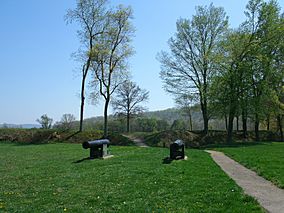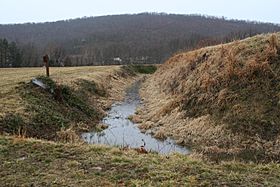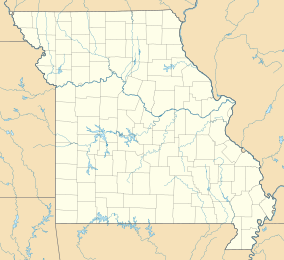Fort Davidson facts for kids
Quick facts for kids Fort DavidsonBattle of Pilot Knob State Historic Site |
|
|---|---|
 |
|
| Location | Pilot Knob, Iron County, Missouri, United States |
| Area | 77.4 acres (31.3 ha) |
| Established | 1968 |
| Visitors | 139,425 (in 2019) |
| Website | Battle of Pilot Knob State Historic Site |
|
Fort Davidson
|
|

Fort Davidson earthworks and moat
|
|
| Location | Pilot Knob, Missouri |
| Area | 9.9 acres (4.0 ha) |
| Built | 1863 |
| NRHP reference No. | 70000332 |
| Added to NRHP | February 26, 1970 |
Fort Davidson is an old military fort near Pilot Knob, Missouri. It was a very important place during the American Civil War. Soldiers from the Union Army built this fort. They used it to defend against attacks from the Confederate side.
A big battle, called the Battle of Fort Davidson, happened here on September 27, 1864. The Union soldiers successfully fought off the Confederate attacks. But that night, they blew up their own fort's ammunition storage (called a magazine) and left. Many soldiers died in the battle and were buried in a large grave at the site.
After the war, the land was used by a mining company. Later, it became part of the United States Forest Service. In 1968, the Battle of Pilot Knob State Historic Site was created. It is now a Missouri State Park. The fort itself was added to the National Register of Historic Places in 1970. Today, you can visit a museum and see the fort's old walls. You can also see the big hole left when the magazine exploded. A monument marks the mass grave.
Contents
Fort Davidson's Story
Fort Davidson is located near Pilot Knob, a town surrounded by four mountains. These mountains are Pilot Knob, Shepherd Mountain, Rock Mountain, and Cedar Hill. Before Fort Davidson, there was another fort called Fort Curtis. Union soldiers built Fort Curtis in 1861, early in the Civil War.
Fort Curtis had many cannons, but its location wasn't perfect. It couldn't easily protect the important iron mines and a nearby railroad. So, in 1863, Fort Davidson was built. It was placed closer to the base of Pilot Knob mountain. This new spot was much better for guarding the valuable resources.
How Fort Davidson Was Built
Fort Davidson was shaped like a hexagon, which is a six-sided figure. Its walls were made of earth. Historians say these walls were either 5 feet or 9 feet high. They were also quite long, about 100 to 150 feet.
Around the fort, there was a wide ditch called a moat. This moat was about 10 feet wide and 6 to 8 feet deep. It made it harder for enemies to reach the fort's walls. Inside the fort, there was an underground magazine. This was where they stored gunpowder and ammunition. It was protected by 15 feet of dirt and wooden planks.
Two long, narrow trenches, called rifle pits, were also built. One was to the north and another to the southwest. These helped soldiers defend the fort. The fort was named after Brigadier General John Wynn Davidson. He had led Union troops in the area a few years earlier.
The Battle of Fort Davidson
In September 1864, a Confederate general named Sterling Price led his army into Missouri. This was part of a plan called Price's Raid. General Price hoped to capture the city of St. Louis. On September 24, he found out that Union soldiers were holding Pilot Knob. He didn't want Union troops behind his army, so he decided to attack.
The Union force at Pilot Knob had about 1,456 soldiers. Some were local militia, and about 150 were civilians helping out. Their commander was Brigadier General Thomas Ewing Jr.. General Ewing was not popular with Confederates. He had issued a controversial order the year before. This order had caused many people to leave their homes in western Missouri.
General Price sent part of his army to the north to cut off the railroad. The rest of his army headed straight for Pilot Knob.
Fighting at the Fort
On the morning of September 27, Confederate troops pushed back Union guards. These guards were in the nearby towns of Arcadia and Ironton. Cannons from Fort Davidson then stopped the Confederate advance. General Ewing moved most of his men inside the fort.
That afternoon, the Confederates tried to place cannons on Shepherd Mountain. But the Union guns inside Fort Davidson fired back. They forced the Confederate cannon crews to leave. General Price planned to attack the fort from five different directions. However, these attacks were not well organized. The Union defenders were able to fight them off one by one.
Few Confederate soldiers even made it to the fort's moat. Those who did could not get past the strong walls. General Price eventually stopped the attacks for the day. He planned to continue fighting the next day.
The Escape and Aftermath
However, that night, the Union defenders secretly left the fort. They also blew up the magazine, causing a huge explosion. Confederate soldiers who were supposed to be watching the escape route didn't notice them leave.
General Ewing's troops had 213 casualties (soldiers killed or wounded). The Confederate army lost between 800 and 1,000 men. Confederate soldiers buried the dead in a large mass grave at the site.
Battle of Pilot Knob State Historic Site
After the Civil War ended in 1865, the fort area was used by a mining company. They kept livestock there. Years later, in 1882, Union veterans held a meeting at the fort to remember the battle. Other veteran groups also met inside the fort's old walls.
In 1905, a local group bought Fort Davidson. They tried to make it a national battlefield, but it didn't happen. Eventually, the land went to General Ewing's son, Thomas. He later gave it to the United States Forest Service.
In 1968 or 1969, the Battle of Pilot Knob State Historic Site became part of the Missouri State Parks system. This happened through an agreement with the Forest Service. By 1969, the fort's walls were about 5 feet high. The crater from the magazine explosion was about 50 feet by 100 feet.
The fort was added to the National Register of Historic Places on February 26, 1970. The Missouri Department of Natural Resources took full control of the site in 1987.
Visiting the Historic Site Today
Today, you can still see the ruins of Fort Davidson at the state historic site. The fort's earthen walls are visible, and so is the large crater. A granite monument marks the mass grave. It has an inscription about letting past disagreements be forgotten.
A visitor center and museum opened in 1991. Inside, you can find a research library and artifacts. These include General Ewing's sword. There's also a special fiber optic display that shows how the battle unfolded.
The park also has a playground, a picnic area, and walking trails. As of 2023, the park covers 77.4 acres. It has six buildings, 3.4 miles of trails, and 0.24 miles of roads. That year, 130,065 people visited the park. The American Battlefield Trust has helped protect 41 acres of the battlefield.
Archaeologists have found many items at the site. These include bullets, bullet fragments, and other military artifacts. They help us learn more about the battle.



